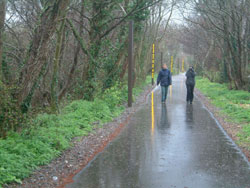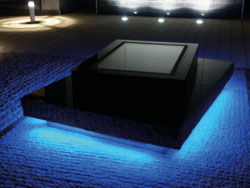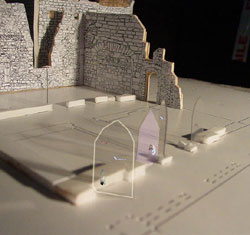PASW Regional Newsletter: Autumn 2004
Focus On Current Projects & Issues
Art in the Landscape, North Devon
Since the completion, in 2000, of the hugely successful 'Art in the Travelling Landscape' project that Northern Devon Coast & Countryside Service delivered in partnership with Sustrans where a number of artworks, benches, waymarkers and shelters, were commissioned for the Tarka Trail from Barnstaple to Okehampton, and we have been working on developing a series of projects under the 'Art in the Landscape' initiative; these four projects are intended as pilots that serve to demonstrate what can be achieved and what is possible when the arts are used as a tool within the context of rural regeneration.
Westward Ho! Sound Bench, by artist Simon Heath was inspired by work developed during a series of workshops with residents in the village where using sound and computer technology, creative ideas for the enhancement of Westward Ho! were explored. Sited on the coast path in the village is a bench, just like every other bench, but with a difference! With the action of sitting down on the bench you trigger a random playback of recorded sounds inspired by the village. From poems to the bingo caller at the arcades, the 200 sounds you hear were recorded exclusively in the village and at a weekend recording event on the seafront last summer.
Velator Wetland Project is primarily about people, access and understanding. The site, owned by the Environment Agency, has until now been closed to the public. In partnership with the EA we developed a project that involved appointing the artist and architect team, San Facon, to realise three very distinct viewing places and spaces, allowing people to look at and experience the wetland site. The artists responded to our desire to use the experience of being on the site as a way of understanding not only the immediate environment but also the wider surrounding environment, including the biosphere reserve and to work with the environment and not against it. Nature conservation on the site was a major consideration for the artists to work with. The community aspect to the work has been essential and the local secondary and primary schools have both been involved in developing projects around the Wetland site. This has also led to the production of a teachers' resource pack enabling and encouraging teachers to use the site across the curriculum subjects.
The project at Slade Reservoir, Moth Black, is about demonstrating how the arts can be used to enhance a place, adding an extra dimension. On the site of a newly created permissive path, artist, Phil Power, has created a kissing gate, style and stone wall constructed seating area. Embedded in the path, as you climb up to the higher reservoir, are solar powered lights that animate your journey. Trees have also been planted in order to delineate the intended path.
The fourth pilot project is possibly the most challenging in terms of the technology involved. Working with young people from Braunton Community College and Youth Club, artist Kirsty Waterworth has developed a series of waymarkers that sit proudly along a section of the cycleway running in to Braunton. These columns of steel house LED displays which have running text written by the young people on them. The text is intended to animate your journey along the cyclepath, taking you on a narrative as well as a physical journey.

Braunton Cycle Path Project
By Kirsty Waterworth and Braunton School pupils
Photo: Lisa Harty
These projects demonstrate how the arts can be used as a tool to tackle a whole range of issues in relation to regenerating and understanding our environment and the communities that inhabit it.
A publication documenting the pilot projects is planned for later in the year.
Lisa Harty, Arts Consultant on behalf of NDCCS
Public Art at Bristol Temple Quay
This spring has seen the completion of a new artwork by John Aiken for Temple Quay , an extensive development of offices and HQ Buildings adjacent to Temple Meads Station and the Floating Harbour in Bristol.
The project is part of SWRDA's commitment to public art and was funded by the Development Agency itself alongside contributions from Castlemore Securities, the developers for the overall site.
Sometimes excellent projects are pre-planned like a military operation and sometimes they come out of a confluence of difficult circumstances that eventually drive the outcome. This was certainly the case here. The issue was the future of a valuable but very vulnerable piece of archaeology on the development site. This was the former River Gate in the city's historic Portwall, that separated the marshland from the trading centre of the medieval city.
Several metres below the current ground level and in rapidly deteriorating condition, this structure became the focus of heated debate about how best to treat it. One side wanted it open for all to see, while others felt it would rapidly crumble and it would be best for it to be recorded and recovered.
The art programme came up with the answer. Geoff Wood who advises SWRDA on public art issues suggested that an artist be commissioned to develop a sculptural solution to both protecting and revealing the River Gate.
John Aiken, Director of the Slade School of Art, was appointed to develop a solution and he also came up with a means of interpreting the route of the historic PortWall as it passes through the site.

Artist: John Aiken, one piece of a six part work
Photo : Nathaniel Rackole
At key points along the route modular sculptures appear in polished black granite. Each subsequent sculpture accrues another piece until they become symmetrical benches underlit with blue neon. The last bench sits over a large, underground, illuminated and environmentally controlled room that houses and protects the Rivergate. The sculpture is enlarged and has a glazed viewing aperture through which the archaeology can be viewed.
The complete artwork is over a hundred metres long and articulates the path between commercial buildings very successfully, whilst providing attractive informal seating for lunchtimes.
More work is planned for the core area of Temple Quay and Geoff Wood is currently advising on the integration of artists' work into Barratt's HomeZone and the 2nd Phase of Temple Quay, north of the Floating Harbour.
Contact details [email protected] or 01422 884538
Commissioning Artists in Princesshay, Exeter - an update
As reported in a previous PASW newsletter, public art consultants Sam Wilkinson and Hazel Colquhoun have created a strategy for involving artists in the redevelopment of the Princesshay area in Exeter city centre. The first artist, Patricia Mackinnon-Day, was appointed in 2003.
A large scale call for expressions of interest has since gone out, using Artist's Newsletter, and Arts Council South West's own newsletter and mailing list. Subsequently, two more artists, Robin Blackledge and Simon Watkinson, have been appointed to the project. Robin will be working with Wilkinson Eyre on a large scale building at the northern entrance to the development and Simon is focusing on a work for a new public space, Bedford Square , working with landscape architects Livingston Eyre, lighting designers BDP and architects Panter Hudspith.

Artist: Patricia Mackinnon-Day, model of proposed work for almshouses, St Catherine's
Photo: Patricia Mackinnon-Day
Patricia Mackinnon-Day's commission is proceeding in the Almshouses, a scheduled ancient monument in St Catherine's Square, which is being remodelled and relandscaped. She has carried out extensive research into the Almshouses and their history and has created a work which re-introduces past inhabitants and activities, using archival and archaeological information. Her work will use glass, text and projection and actual archaeological objects found on the site. The old chapel on the site will be animated through a subtle light work.
Hazel Colquhoun
PROJECT-engaging artists in the built environment
Public art in Britain has moved on enormously from the days of monolithic, enigmatic memorials left in the wake of some new town centre development or housing project. We've seen a swing towards community involvement to the extent of communities making work themselves, often it has to be said, with mixed results. We have a percent for art system that has been adopted by many local authorities and agencies around the UK , an amazing step forward that has sadly not always provided the quality and inspiration that we had hoped for. There exists now a network of public art agencies who work to put all of this right, and to help inject quality into the process of creating work, whether funded by developers or by the many public funding streams dedicated to this cause.
So what makes the difference between bad, good and great public art? The difference between the good and the great will always be a subject for debate, as it is in the world of design, with time becoming the ultimate arbiter. But the difference between the bad and the good is not, I would argue, a purely subjective matter.
Oscar Wilde said something like:
"All the ugly things in this world have been made by someone trying to make something beautiful, and all the beautiful things by someone trying to make something that works."
This is easy to apply to design ñ that form often follows function ñ but it can also apply to public art in the sense that a work needs to be fit for purpose and location; whether that purpose is to simply celebrate a community event or to show the best that can be created in a particular medium.
So how can we create the conditions for good public art to emerge and to thrive? What are the lessons to be learned from good percent for art projects or schemes that have engaged communities with positive results? Experience tells us that it is often those schemes where meaningful consideration, preparation and deliberation have taken place that are the most successful. Not necessarily where there is unanimous support up front ñ the Angel of the North would not be with us were that the case ñ but where there has been a real dialogue. This kind of dialogue is beginning a new movement in public art that is not about making work at all, but is more about the role of the artist in transforming the environment as a whole. In many cases this has and will lead to: the making of more and better quality public art that is fit for purpose, greater acceptance and spending from developers, and ultimately a higher quality built environment.
This is exactly the kind of change that we are seeking to effect through jointly funding the ëPROJECT' programme with Arts & Business. It is a genuinely challenging but exciting programme that will see artists taking on new roles in regeneration and growth areas, working as part of multidisciplinary teams on Masterplans and contributing creativity to transforming neighbourhoods. I believe that it will ultimately increase the quantity and quality of public art in our towns and cities, but in a sense more importantly, I know that it will generate a new role for the arts and for artists that will lead to a better built environment including public and green spaces.
We are delighted to have appointed PASW to lead this innovative programme. Although funded activity will cover the whole of the UK , working with an organisation that understands life at the regional level is essential to this scheme.
The first award recipients will be announced in the specialist press in early November and on www.project-awards.org.uk
Chris Murray, Commission for Architecture and the Built Environment [email protected]
Plymouth Area Health Community, Vanguard Health Programme
The way healthcare services are delivered in the Plymouth area health community is about to change. Services are being redesigned to create a more patient-focused way of doing things, with, amongst other things, a wider range of services being provided closer to home, booked hospital appointments, day case operations reducing the need to stay in hospital.
These new services will be delivered in a different kind of healthcare environment, one that is both welcoming and easily accessible for patients. This new environment will be created by refurbishing existing premises and building new ones. These changes will be mainly funded by a combination of PFI (Private finance Initiatives), LIFT (Local Improvement Finance Trust) and Strategic Capital, delivered by the Vanguard Health Programme.
Vanguard is committed to delivering this improved service from high quality premises. As part of this commitment, Plymouth Hospitals NHS Trust and Plymouth Teaching Primary Care Trust, have created a new post of Arts & Design Development Officer.
Public Art South West were approached by Plymouth Hospitals for help to frame an application to Arts Council England, South West for a grant to fund this important strategic post. In March, Plymouth Hospitals submitted an application for a grant of £70K over three years. Plymouth Hospitals has just been informed that their application has been successful and that they have been awarded the funding.
Plymouth Hospitals, working with the Vanguard Arts Steering Committee, comprising representatives from the health, education and community sectors will now recruit an experienced arts professional to work as part of the joint planning team in order to provide a 21st century healthcare environment for the Plymouth area health community.
This exciting new appointment, highlights the increasing importance being placed on good art and design, together with community involvement in creating new public buildings we can all take pride in.
Peggie Johnson, Service Development Co-ordinator
